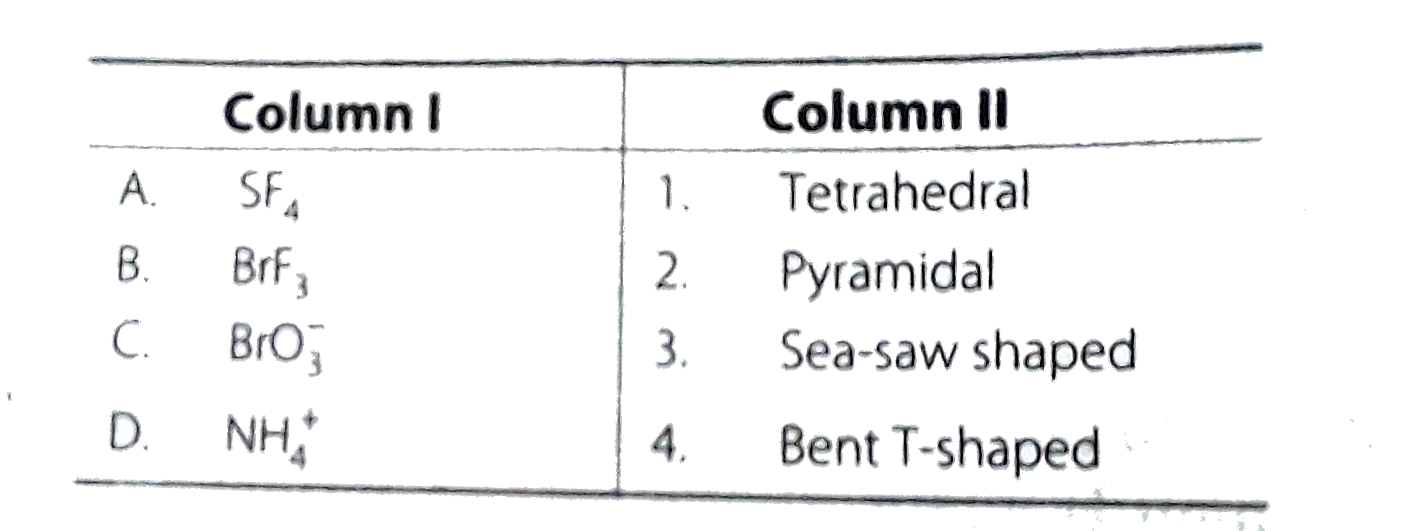Match the linear equations given in Column-I with their solutions given in Column-II and select the correct option.
Column-IColumn-II(P)5x=−2y+7(a)(0,0)(Q)4x−6y=0(b)(2,0)(R)3y=53x+7(c)(3,−4)(S)2x−y=4(d)(3,4)
(P)→(b),(Q)→(c),(R)→(a),(S)→(d)
(P)→(c),(Q)→(b),(R)→(d),(S)→(a)
(P)→(c),(Q)→(a),(R)→(d),(S)→(b)
(P)→(d),(Q)→(b),(R)→(a),(S)→(c)
The correct Answer is:C
To solve the problem of matching the linear equations from Column-I with their corresponding solutions from Column-II, we will evaluate each equation with the given points in Column-II.
Step 1: Analyze the equations and points
We have the following equations in Column-I:
1. P:5x=−2y+7
2. Q:4x−6y=0
3. R:3y=53x+7
4. S:2x−y=4
And the points in Column-II:
- a:(0,0)
- b:(2,0)
- c:(3,−4)
- d:(3,4)
Step 2: Substitute the points into the equations
For Equation P: 5x=−2y+7
1. Check point a:(0,0)
5(0)=−2(0)+7⟹0=7(False)
2. Check point b:(2,0)
5(2)=−2(0)+7⟹10=7(False)
3. Check point c:(3,−4)
5(3)=−2(−4)+7⟹15=8+7⟹15=15(True)
4. Check point d:(3,4)
5(3)=−2(4)+7⟹15=−8+7⟹15=−1(False)
Match for P: (3,-4) → c
For Equation Q: 4x−6y=0
1. Check point a:(0,0)
4(0)−6(0)=0⟹0=0(True)
2. Check point b:(2,0)
4(2)−6(0)=0⟹8=0(False)
3. Check point c:(3,−4)
4(3)−6(−4)=0⟹12+24=0(False)
4. Check point d:(3,4)
4(3)−6(4)=0⟹12−24=0(False)
Match for Q: (0,0) → a
For Equation R: 3y=53x+7
1. Check point a:(0,0)
3(0)=53(0)+7⟹0=7(False)
2. Check point b:(2,0)
3(0)=53(2)+7⟹0=103+7(False)
3. Check point c:(3,−4)
3(−4)=53(3)+7⟹−12=5+7⟹−12=12(False)
4. Check point d:(3,4)
3(4)=53(3)+7⟹12=5+7⟹12=12(True)
Match for R: (3,4) → d
For Equation S: 2x−y=4
1. Check point a:(0,0)
2(0)−0=4⟹0=4(False)
2. Check point b:(2,0)
2(2)−0=4⟹4=4(True)
3. Check point c:(3,−4)
2(3)−(−4)=4⟹6+4=4(False)
4. Check point d:(3,4)
2(3)−4=4⟹6−4=4(False)
Match for S: (2,0) → b
Final Matches
- P matches with c (3,-4)
- Q matches with a (0,0)
- R matches with d (3,4)
- S matches with b (2,0)
Summary of Matches
- P → c
- Q → a
- R → d
- S → b
1. P:5x=−2y+7
2. Q:4x−6y=0
3. R:3y=53x+7
4. S:2x−y=4
- a:(0,0)
- b:(2,0)
- c:(3,−4)
- d:(3,4)
1. Check point a:(0,0)
5(0)=−2(0)+7⟹0=7(False)
2. Check point b:(2,0)
5(2)=−2(0)+7⟹10=7(False)
3. Check point c:(3,−4)
5(3)=−2(−4)+7⟹15=8+7⟹15=15(True)
4. Check point d:(3,4)
5(3)=−2(4)+7⟹15=−8+7⟹15=−1(False)
1. Check point a:(0,0)
4(0)−6(0)=0⟹0=0(True)
2. Check point b:(2,0)
4(2)−6(0)=0⟹8=0(False)
3. Check point c:(3,−4)
4(3)−6(−4)=0⟹12+24=0(False)
4. Check point d:(3,4)
4(3)−6(4)=0⟹12−24=0(False)
1. Check point a:(0,0)
3(0)=53(0)+7⟹0=7(False)
2. Check point b:(2,0)
3(0)=53(2)+7⟹0=103+7(False)
3. Check point c:(3,−4)
3(−4)=53(3)+7⟹−12=5+7⟹−12=12(False)
4. Check point d:(3,4)
3(4)=53(3)+7⟹12=5+7⟹12=12(True)
1. Check point a:(0,0)
2(0)−0=4⟹0=4(False)
2. Check point b:(2,0)
2(2)−0=4⟹4=4(True)
3. Check point c:(3,−4)
2(3)−(−4)=4⟹6+4=4(False)
4. Check point d:(3,4)
2(3)−4=4⟹6−4=4(False)
- P matches with c (3,-4)
- Q matches with a (0,0)
- R matches with d (3,4)
- S matches with b (2,0)
- P → c
- Q → a
- R → d
- S → b
Topper's Solved these Questions
- IMO QUESTION PAPER 2018 SET B BOOK - SCIENCE OLYMPIAD FOUNDATION CHAPTER - IMO QUESTION PAPER 2018 SET B EXERCISE - Everyday mathematics
10 Videos
- IMO QUESTION PAPER 2018 SET ABOOK - SCIENCE OLYMPIAD FOUNDATION CHAPTER - IMO QUESTION PAPER 2018 SET AEXERCISE - ACHIEVERS SECTION
5 Videos
- IMO QUESTION PAPER 2020 SET 1BOOK - SCIENCE OLYMPIAD FOUNDATION CHAPTER - IMO QUESTION PAPER 2020 SET 1EXERCISE - Achievers Section
5 Videos
Similar Questions
Match species given in Column I with the electronic configuration given in Column II.
Column IColumn II(a)cr(i)[Ar]3d84s0(b)Fe2+(ii)[Ar]3d104s1(c)Ni2+(iii)[Ar]3d64s0(d)Cu(iv)[Ar]3d54s1(v)[Ar]3d64s2
View SolutionMatch Column I with Column II for the oxidation states of the central atoms .
Column IColumn II(i)Cr2O2−7(a)+3(ii)MnO−4(b)+4(iii)VO−3(c)+5(iv)FeF3−6(e)+7
View Solution
Knowledge Check
Match the species given in Column I with the shape given in Column II and mark the correct option.
 AA(3)B(2)C(1)D(4)BA(3)B(4)C(2)D(1)CA(1)B(2)C(3)D(4)DA(1)B(4)C(3)D(2)
AA(3)B(2)C(1)D(4)BA(3)B(4)C(2)D(1)CA(1)B(2)C(3)D(4)DA(1)B(4)C(3)D(2)Match the compounds given in Column I with the oxidation state of cobalt present in it (given in Column II) and assign the correct code.
Column I (Compound)Column I (Oxidation state of Co)A.[Co(NCS)(NH3)5](SO3)1.+4B.[Co(NH3)4Cl2]SO42.0C.Na4[Co(S2O3)3]3.+1D.[Co2(CO)8]4.+25.+3AA (1)B (2)C (4)D (5)BA (4)B (3)C (2)D (1)CA (5)B (1)C (4)D (2)DA (4)B (1)C (2)D (3)Match the complexed listed column −I with type of hybridisation listed in column −II and select the correct answer using the code given below the lists :
Column−IColumn−II(a)[AuF4]−(p) dsp2hybridisation(b)[Cu(CN)4]3−(q) sp3hybridisation(c)[Co(NH3)6]3+(r) sp3d2hybridisation(d)[Fe(H2O)5NO]2+(s) d2sp3hybridisationA(a)(b)(c)(d)pqsrB(a)(b)(c)(d)psqrC(a)(b)(c)(d)qprsD(a)(b)(c)(d)sqpr
Match Column I with Column II for the oxidation states of the central atoms .
Column IColumn II(i)Cr2O2−7(a)+3(ii)MnO−4(b)+4(iii)VO−3(c)+5(iv)FeF3−6(e)+7
View SolutionMatch species given in Column I with the electronic configuration given in Column II.
Column IColumn II(a)cr(i)[Ar]3d84s0(b)Fe2+(ii)[Ar]3d104s1(c)Ni2+(iii)[Ar]3d64s0(d)Cu(iv)[Ar]3d54s1(v)[Ar]3d64s2
View SolutionMatch Column I with Column II for the oxidation states of the central atoms .
Column IColumn II(i)Cr2O2−7(a)+3(ii)MnO−4(b)+4(iii)VO−3(c)+5(iv)FeF3−6(e)+7
View SolutionIn normal YDSE experiment maximum intensity is 4I0 in Column I, y-coordinate is given corresponding to centre line In Coloum II resultant intensities are given Match the two columns.
Column IColumn IIAy=λDdp.I=I0By=λD2dq.I=2I0Cy=λD3dr.I=4I0Dy=λD4ds.I=zero
View SolutionMatch the elements given in column (I) with the most appropriat expected values given in column II
Column IColumn IIElementElectronegative valuesA.F(p)3.5B.O(q)3.0C.N(r)4.0D.C(s)2.5
View Solution
